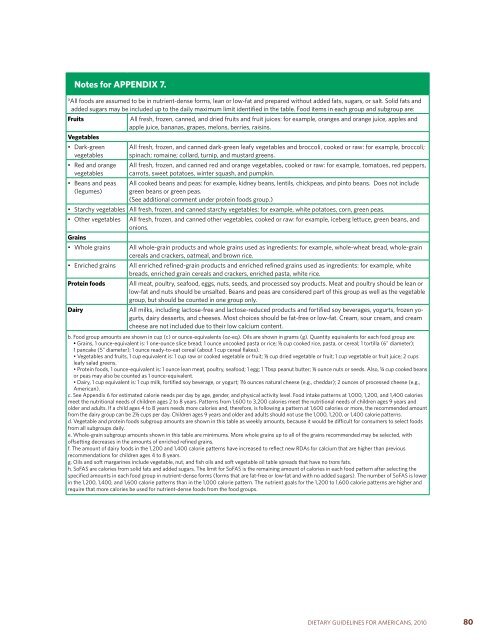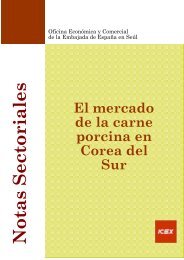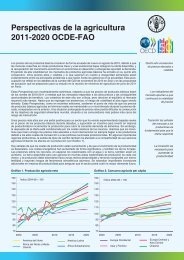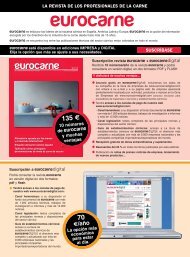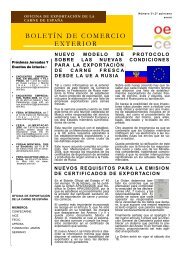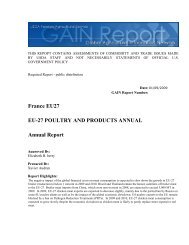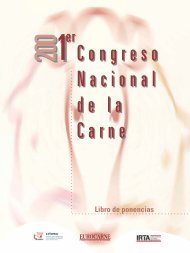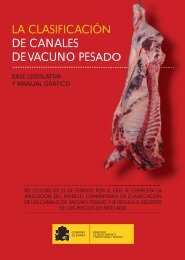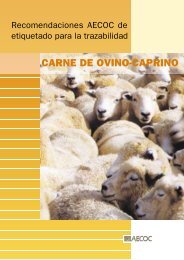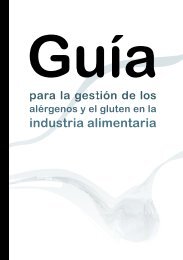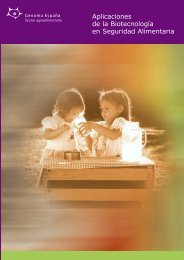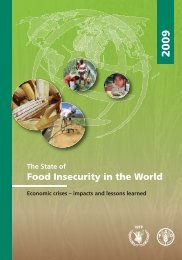Dietary Guidelines for Americans - SchoolNutritionAndFitness.com
Dietary Guidelines for Americans - SchoolNutritionAndFitness.com
Dietary Guidelines for Americans - SchoolNutritionAndFitness.com
- No tags were found...
You also want an ePaper? Increase the reach of your titles
YUMPU automatically turns print PDFs into web optimized ePapers that Google loves.
notes <strong>for</strong> aPPendix 7.a All foods are assumed to be in nutrient-dense <strong>for</strong>ms, lean or low-fat and prepared without added fats, sugars, or salt. Solid fats andadded sugars may be included up to the daily maximum limit identified in the table. Food items in each group and subgroup are:fruitsAll fresh, frozen, canned, and dried fruits and fruit juices: <strong>for</strong> example, oranges and orange juice, apples andapple juice, bananas, grapes, melons, berries, raisins.vegetables• Dark-greenvegetables• Red and orangevegetables• Beans and peas(legumes)All fresh, frozen, and canned dark-green leafy vegetables and broccoli, cooked or raw: <strong>for</strong> example, broccoli;spinach; romaine; collard, turnip, and mustard greens.All fresh, frozen, and canned red and orange vegetables, cooked or raw: <strong>for</strong> example, tomatoes, red peppers,carrots, sweet potatoes, winter squash, and pumpkin.All cooked beans and peas: <strong>for</strong> example, kidney beans, lentils, chickpeas, and pinto beans. Does not includegreen beans or green peas.(See additional <strong>com</strong>ment under protein foods group.)• Starchy vegetables All fresh, frozen, and canned starchy vegetables: <strong>for</strong> example, white potatoes, corn, green peas.• Other vegetables All fresh, frozen, and canned other vegetables, cooked or raw: <strong>for</strong> example, iceberg lettuce, green beans, andonions.grains• Whole grains All whole-grain products and whole grains used as ingredients: <strong>for</strong> example, whole-wheat bread, whole-graincereals and crackers, oatmeal, and brown rice.• Enriched grains All enriched refined-grain products and enriched refined grains used as ingredients: <strong>for</strong> example, whitebreads, enriched grain cereals and crackers, enriched pasta, white rice.Protein foods All meat, poultry, seafood, eggs, nuts, seeds, and processed soy products. Meat and poultry should be lean orlow-fat and nuts should be unsalted. Beans and peas are considered part of this group as well as the vegetablegroup, but should be counted in one group only.dairyAll milks, including lactose-free and lactose-reduced products and <strong>for</strong>tified soy beverages, yogurts, frozen yogurts,dairy desserts, and cheeses. Most choices should be fat-free or low-fat. Cream, sour cream, and creamcheese are not included due to their low calcium content.b. Food group amounts are shown in cup (c) or ounce-equivalents (oz-eq). Oils are shown in grams (g). Quantity equivalents <strong>for</strong> each food group are:• Grains, 1 ounce-equivalent is: 1 one-ounce slice bread; 1 ounce uncooked pasta or rice; ½ cup cooked rice, pasta, or cereal; 1 tortilla (6" diameter);1 pancake (5" diameter); 1 ounce ready-to-eat cereal (about 1 cup cereal flakes).• Vegetables and fruits, 1 cup equivalent is: 1 cup raw or cooked vegetable or fruit; ½ cup dried vegetable or fruit; 1 cup vegetable or fruit juice; 2 cupsleafy salad greens.• Protein foods, 1 ounce-equivalent is: 1 ounce lean meat, poultry, seafood; 1 egg; 1 Tbsp peanut butter; ½ ounce nuts or seeds. Also, ¼ cup cooked beansor peas may also be counted as 1 ounce-equivalent.• Dairy, 1 cup equivalent is: 1 cup milk, <strong>for</strong>tified soy beverage, or yogurt; 1½ ounces natural cheese (e.g., cheddar); 2 ounces of processed cheese (e.g.,American).c. See Appendix 6 <strong>for</strong> estimated calorie needs per day by age, gender, and physical activity level. Food intake patterns at 1,000, 1,200, and 1,400 caloriesmeet the nutritional needs of children ages 2 to 8 years. Patterns from 1,600 to 3,200 calories meet the nutritional needs of children ages 9 years andolder and adults. If a child ages 4 to 8 years needs more calories and, there<strong>for</strong>e, is following a pattern at 1,600 calories or more, the re<strong>com</strong>mended amountfrom the dairy group can be 2½ cups per day. Children ages 9 years and older and adults should not use the 1,000, 1,200, or 1,400 calorie patterns.d. Vegetable and protein foods subgroup amounts are shown in this table as weekly amounts, because it would be difficult <strong>for</strong> consumers to select foodsfrom all subgroups daily.e. Whole-grain subgroup amounts shown in this table are minimums. More whole grains up to all of the grains re<strong>com</strong>mended may be selected, withoffsetting decreases in the amounts of enriched refined grains.f. The amount of dairy foods in the 1,200 and 1,400 calorie patterns have increased to reflect new RDAs <strong>for</strong> calcium that are higher than previousre<strong>com</strong>mendations <strong>for</strong> children ages 4 to 8 years.g. Oils and soft margarines include vegetable, nut, and fish oils and soft vegetable oil table spreads that have no trans fats.h. SoFAS are calories from solid fats and added sugars. The limit <strong>for</strong> SoFAS is the remaining amount of calories in each food pattern after selecting thespecified amounts in each food group in nutrient-dense <strong>for</strong>ms (<strong>for</strong>ms that are fat-free or low-fat and with no added sugars). The number of SoFAS is lowerin the 1,200, 1,400, and 1,600 calorie patterns than in the 1,000 calorie pattern. The nutrient goals <strong>for</strong> the 1,200 to 1,600 calorie patterns are higher andrequire that more calories be used <strong>for</strong> nutrient-dense foods from the food groups.DIETARY GUIDELINES FOR AMERICANS, 2010 80


